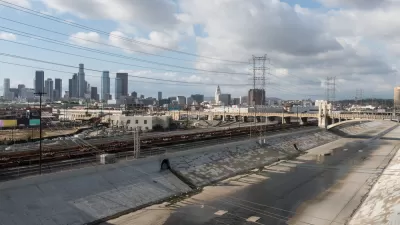A Los Angeles Times editorial argues that Skid Row’s future should learn from the mistakes of the past.

There’s a wrinkle included in the proposed community plan for Downtown Los Angeles (DTLA 2040) that has provoked concern from observers, including an editorial from the Los Angeles Times.
The wrinkle in question is a zoning district in the city’s Skid Row that would only allow affordable housing development. The blocks between between 5th and 7th streets and San Pedro Street and Central Avenue would be zoned as IX1, a new zone allowing for “mixed industrial use.” According to the Los Angeles Time Editorial Board, the new zone will create “the first area of the city with new housing reserved for residents defined as acutely low income (homeless or almost) to moderately low income.”
As noted in the editorial, however, the state of Skid Row in 2023 is a result of a 1970s approach to homelessness that concentrated services in this one section of the city near Downtown.
“In the 1970s the city adopted an official policy of ‘containment’ — concentrating cheap hotels, shelters and service agencies on skid row to both take care of residents and prevent them from setting up in other parts of downtown or the city. It was born of a desire by leaders to help and also to wipe their hands of the misery there,” explains the editorial.
Skeptics of the new zoning code point out the similarities between the new plan with the containment of previous decades. The editorial, however, calls for a new future for Skid Row—one that allows both affordable housing and market-rate housing.
The editorial, linked below, proposes a solution that would require higher portions of affordable housing, or a cap on market rate development in the area. “The goal in this particularly impoverished community is to make room for more housing and more investment to lift up the neighborhood. Making skid row more of a mixed-income community need not displace current residents or services, if done carefully,” according to the editorial.
FULL STORY: Editorial: Let skid row have affordable and market-rate housing. It’s the forward-looking thing to do

Study: Maui’s Plan to Convert Vacation Rentals to Long-Term Housing Could Cause Nearly $1 Billion Economic Loss
The plan would reduce visitor accommodation by 25,% resulting in 1,900 jobs lost.

North Texas Transit Leaders Tout Benefits of TOD for Growing Region
At a summit focused on transit-oriented development, policymakers discussed how North Texas’ expanded light rail system can serve as a tool for economic growth.

Using Old Oil and Gas Wells for Green Energy Storage
Penn State researchers have found that repurposing abandoned oil and gas wells for geothermal-assisted compressed-air energy storage can boost efficiency, reduce environmental risks, and support clean energy and job transitions.

Santa Barbara Could Build Housing on County Land
County supervisors moved forward a proposal to build workforce housing on two county-owned parcels.

San Mateo Formally Opposes Freeway Project
The city council will send a letter to Caltrans urging the agency to reconsider a plan to expand the 101 through the city of San Mateo.

A Bronx Community Fights to Have its Voice Heard
After organizing and giving input for decades, the community around the Kingsbridge Armory might actually see it redeveloped — and they want to continue to have a say in how it goes.
Urban Design for Planners 1: Software Tools
This six-course series explores essential urban design concepts using open source software and equips planners with the tools they need to participate fully in the urban design process.
Planning for Universal Design
Learn the tools for implementing Universal Design in planning regulations.
Ascent Environmental
Borough of Carlisle
Institute for Housing and Urban Development Studies (IHS)
City of Grandview
Harvard GSD Executive Education
Toledo-Lucas County Plan Commissions
Salt Lake City
NYU Wagner Graduate School of Public Service




























